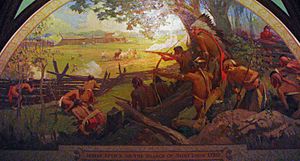Matchekewis facts for kids
Matchekewis (born around 1735, died July 1805) was an important Ojibwe leader. He was also known by names like Madjeckewiss or Bad Bird. Matchekewis was a respected war chief from what is now northern Michigan. He became famous for his part in capturing Fort Michilimackinac from the British in 1763. This happened during a conflict known as Pontiac's War. Later, he became a strong friend and helper to Great Britain during the American Revolutionary War.
Contents
Matchekewis: A Native American Leader
Matchekewis played a big role in the history of Native American tribes in the 18th century. He was a skilled leader and warrior. His actions affected many people and changed the control of lands in North America. He fought for his people and made important decisions for them.
Early Life and Role in Pontiac's War
Matchekewis was born around 1735. He grew up to be a respected war chief among the Ojibwe people. A war chief was a leader who guided warriors in battles. In 1763, he joined Pontiac's War, which was a large uprising by Native American tribes. They were fighting against British control after the French and Indian War.
Capturing Fort Michilimackinac
One of the most famous events Matchekewis was involved in was the capture of Fort Michilimackinac. This fort was a key British trading post and military base. It was located in what is now Mackinaw City, Michigan. On June 2, 1763, Ojibwe and Sauk warriors used a clever trick to take the fort. They pretended to play a game of lacrosse outside the fort's walls. While the British soldiers watched, the ball was thrown near the fort's gate. The warriors rushed in, surprising the British. Matchekewis was a leader in this successful attack.
Matchekewis and the American Revolution
Years later, the American Revolutionary War began. This was a fight between Great Britain and its American colonies. Matchekewis chose to support Great Britain. He led his warriors as allies of the British. They fought against the Spanish, who were helping the American colonists.
The Battle of St. Louis
In 1780, Matchekewis led all the Native American troops in a battle against the Spanish. This battle took place at St. Louis, which was then a Spanish settlement. Matchekewis and his warriors fought bravely. However, the Spanish had powerful gunpowder weapons. These weapons gave them an advantage. Matchekewis and his forces were eventually defeated.
Later Life and Treaties
After the American Revolutionary War ended, the United States became an independent country. Matchekewis then signed an important agreement with the new United States. This agreement was called the Treaty of Greenville. It was signed in 1795. In this treaty, Matchekewis agreed to give up some lands. These lands included Bois Blanc Island in Lake Huron. He also gave up other lands that originally belonged to his people. This treaty helped to define the boundaries between Native American territories and the growing United States. Matchekewis passed away in July 1805.


